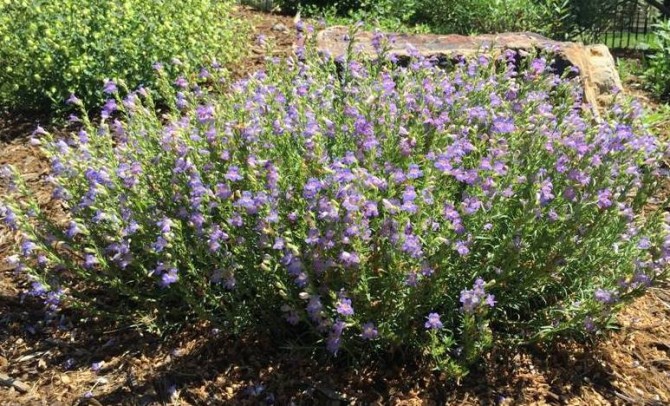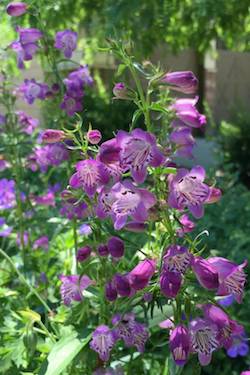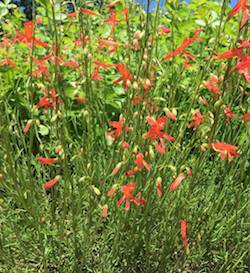
By Erika Strote
Colorado State University Extension Master Gardener in Larimer County
It may be hard to recall, given the amount of moisture we have seen this spring and summer, but the ongoing drought that is occurring in many areas of the western United States serves to remind us that water is a precious resource. Many gardeners are rethinking the plants they grow in order to conserve the amount of water they use in their landscape. Luckily, gardening with water conservation in mind does not mean that our gardens will lack variety and color. Many of the garden centers in our area provide water wise plants, and some of these plants are also plants native to our area, which means they are better adapted to our specific soil and weather.
Of the many different water wise plants available, one perennial that deserves special notice is penstemon. With more than 250 varieties of penstemon in a rainbow of colors, including a whopping 62 species native to Colorado, there are ample options from which to choose. The different varieties have distinct personalities, from delicate mat-forming penstemon only a few inches high to penstemon with flower spikes that top out at several feet tall.
 Although there is great range in the species, all penstemon flowers are similarly shaped, with a tubular body that flares open and an upper and lower lip at the edge of the body. The upper lip of the flower has two lobes, while the lower lip has three. Penstemon is commonly referred to as “beardtongue” because some of the varieties have a hairy-looking tongue (actually an infertile pollen sac) that protrudes from the throat of the flowers.
Although there is great range in the species, all penstemon flowers are similarly shaped, with a tubular body that flares open and an upper and lower lip at the edge of the body. The upper lip of the flower has two lobes, while the lower lip has three. Penstemon is commonly referred to as “beardtongue” because some of the varieties have a hairy-looking tongue (actually an infertile pollen sac) that protrudes from the throat of the flowers.
Whether you have a hot spot in your garden that requires a plant that won’t mind the lack of water, you want to attract hummingbirds and butterflies, or you need a plant that will naturalize into your landscape, there is a penstemon just right for the job. Even the most particular gardener should be able to find a variety to love.
One of our native penstemon, Penstemon strictus, or Rocky Mountain penstemon, with bright purple-blue flowers on up to 30” spikes and evergreen foliage, is one of the easiest to grow. It is long-lived and fuss-free. Planted in a spot with well-drained soil and exposure to full sun, it will put on a show in mid- to late spring.
Mexicali Penstemons, a hybrid between penstemon native to Mexico with large showy flowers and our more cold hardy native penstemon, are real showstoppers in the garden with brightly colored blooms and glossy foliage. They start blooming in the early summer on 18” spikes and continue to bloom sporadically throughout the summer if they are kept deadheaded. If allowed to set seed in the fall, they will naturalize and multiply without becoming a garden bully. For those gardeners who prefer a tidy garden, simply snip the spent flower stalks off to prevent the plant from self-sowing.
Another variety of penstemon commonly found in our garden centers is pineleaf penstemon (Penstemon pinifolius). These plants have attractive needle-like evergreen foliage. The flowers, multiple blooms rising on narrow, delicate spikes, are tubular and most commonly found in shades of orange and red. There is also a yellow flowered variety available, which is rare to find in the penstemon color range.
 A delightful, low growing penstemon variety, Blue Lips, is a hybrid cross between two native species, Penstemon crandallii and P. linariodes var coloradensis. The evergreen foliage is a greyish blue shade, and the 8” flower spikes are covered with blue and lavender flowers in the early summer. Once the bloom is over, it is simple to shear off the spent flower spikes and display the attractive mat-forming foliage.
A delightful, low growing penstemon variety, Blue Lips, is a hybrid cross between two native species, Penstemon crandallii and P. linariodes var coloradensis. The evergreen foliage is a greyish blue shade, and the 8” flower spikes are covered with blue and lavender flowers in the early summer. Once the bloom is over, it is simple to shear off the spent flower spikes and display the attractive mat-forming foliage.
Peek around at your favorite nursery and you will find many others varieties to choose from. Plant one variety or select several different varieties to add a mix of colors to your yard. Just be aware that some types of penstemon, if allowed to go to seed, will hybridize when planted closely together.
Penstemon are low maintenance. In fact, they thrive in the kinds of conditions that fussier plants will not tolerate. The main requirement for success is that they need to be planted in well-drained soil—they do not like to have wet feet or crowns. They do best in lean soil without any additional amendments. Most of them appreciate full sun, but some varieties will tolerate afternoon shade.
Another great feature of this perennial is that they help sustain pollinators. Hummingbirds, bees, butterflies and moths all happily visit the long throated flowers. In addition, selecting penstemon varieties that are native to this area helps to encourage populations of native pollinators.
For more information about penstemon, check out the CSU Extension Fact Sheet on Native Herbaceous Perennials for Colorado Landscapes (#7.242) at:
http://www.ext.colostate.edu/pubs/garden/07242.html
The following links also contain information about growing penstemon:
http://habhero.org/mexicali-penstemons-easy-to-grow-perennials/
http://www.unce.unr.edu/publications/files/ho/2013/fs1335.pdf
The author has received training through Colorado State University Extension’s Master Gardener program and is a Master Gardener volunteer for Larimer County.
Larimer County is a county-based outreach of Colorado State University Extension providing information you can trust to deal with current issues in agriculture, horticulture, nutrition and food safety, 4-H, small acreage, money management and parenting. For more information about CSU Extension in Larimer County, call (970) 498-6000 or visit www.larimer.org/ext
Looking for additional gardening information? Check out the CSU Extension Horticulture Agent blog at www.csuhort.blogspot.com for timely updates about gardening around the state.
Visit PlantTalk Colorado ™ for fast answers to your gardening questions! www.planttalk.org PlantTalk is a cooperation between Colorado State University Extension, GreenCo and Denver Botanic Gardens.